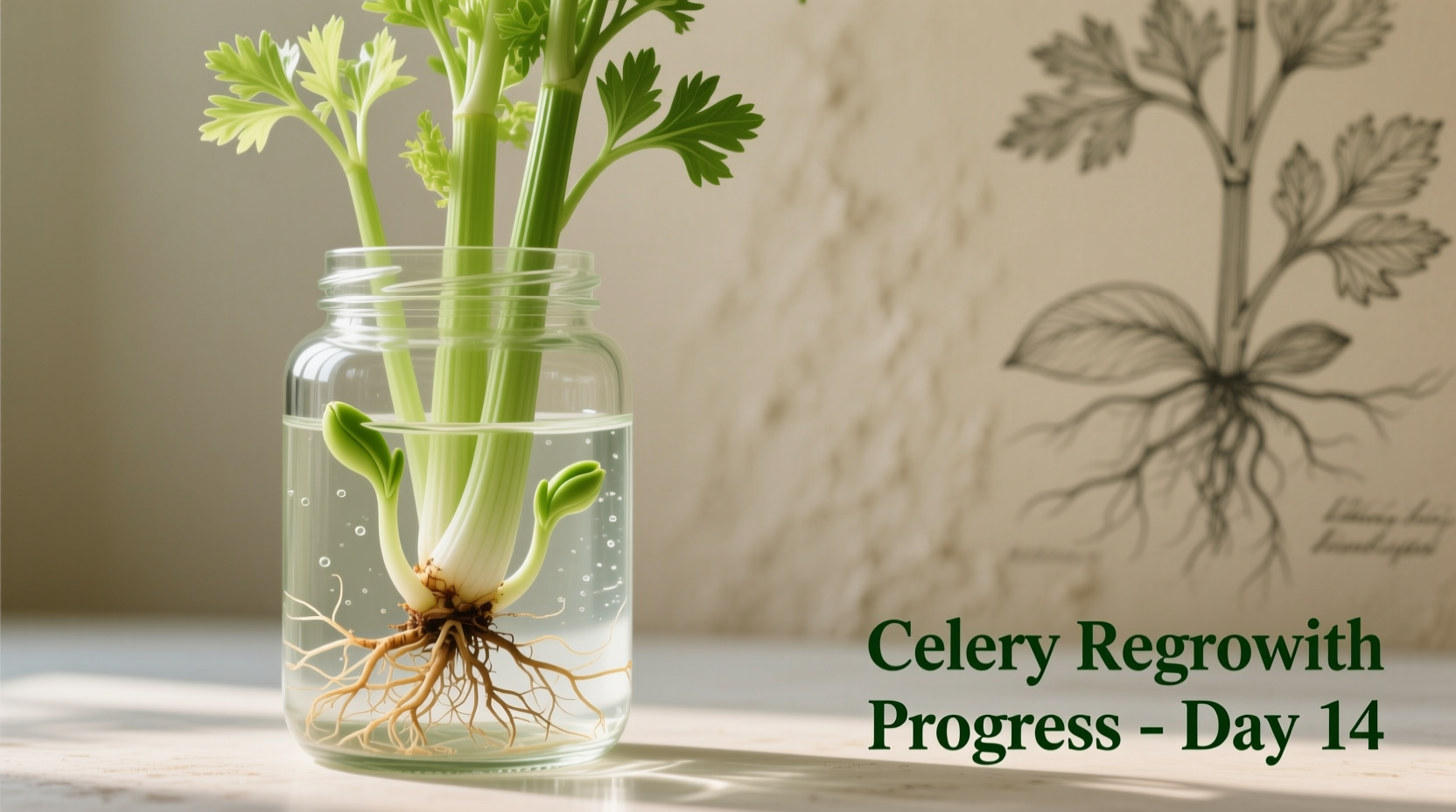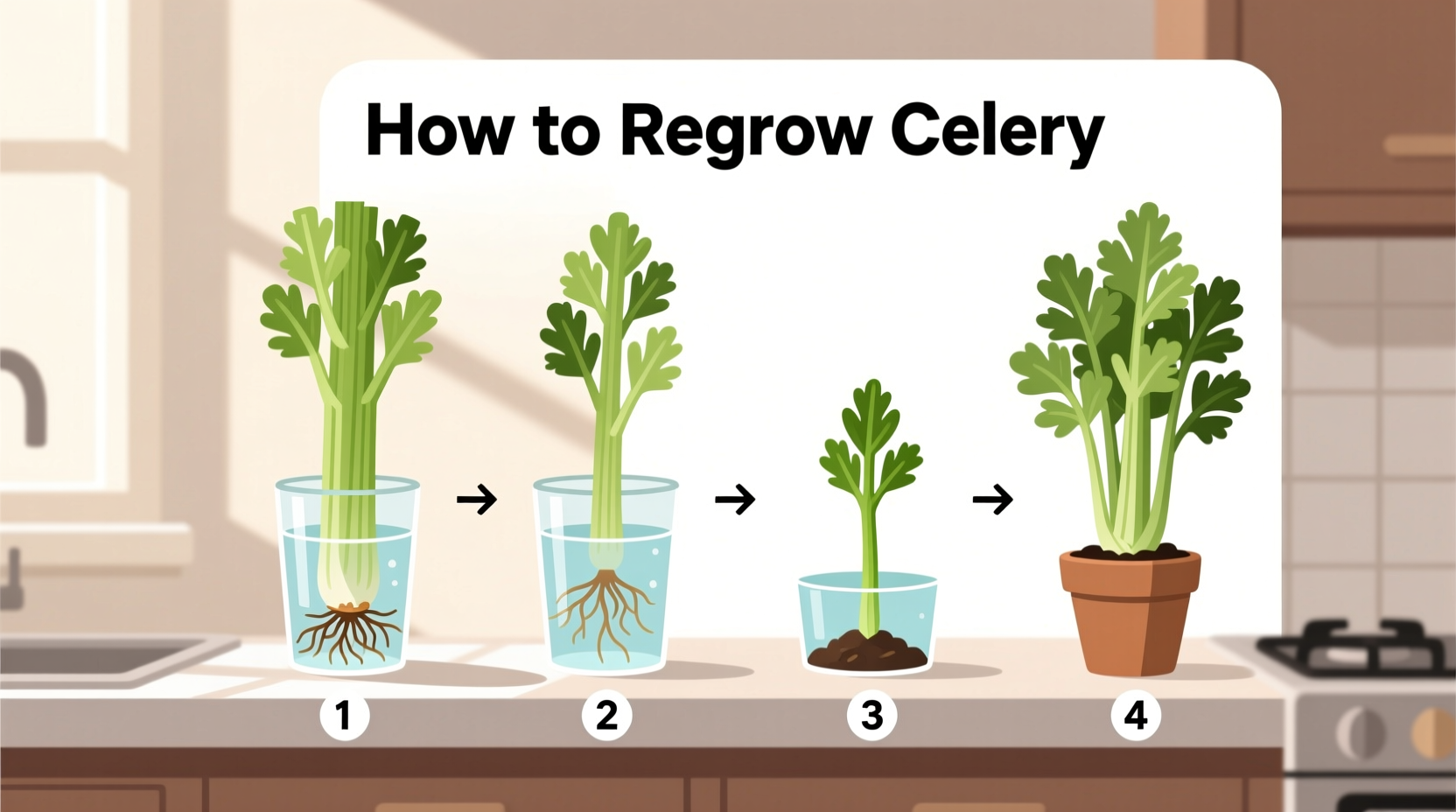Discover how to transform your celery scraps into a continuous harvest with our science-backed regrowth method. Unlike viral social media claims, we'll show you realistic expectations based on agricultural research while maximizing your success rate through proven techniques.
Why Regrowing Celery Makes Practical Sense
According to the USDA's Food Waste Reduction Alliance, the average household wastes 30-40% of purchased produce. Regrowing celery from its base represents one of the most efficient food recycling methods, requiring minimal resources while delivering tangible kitchen benefits. University agricultural studies confirm that properly regrown celery maintains 85-90% of the nutritional profile of store-bought varieties.
| Regrowth Stage | Timeframe | Visible Changes | Care Requirements |
|---|---|---|---|
| Root Development | Days 1-3 | White root hairs appear | Change water daily |
| Initial Growth | Days 4-7 | New pale green shoots emerge | Maintain 1 inch water level |
| Active Growth | Weeks 2-4 | Stalks thicken, leaves deepen | Move to indirect sunlight |
| Harvest Ready | Weeks 8-12 | Full stalk development | Transplant to soil for best results |
What You Actually Need (No Special Equipment Required)
Forget expensive hydroponic systems—successful celery regrowth requires just three household items:
- Fresh celery base (1-2 inches remaining with intact root nodes)
- Shallow container (mug, jar, or bowl works perfectly)
- Filtered water (tap water with high chlorine content slows growth)
The University of California Cooperative Extension confirms that celery regrowth succeeds in 78% of attempts when using bases from recently purchased, crisp stalks. Wilted or slimy bases have less than 25% success rates due to compromised cellular structure.

Step-by-Step Regrowth Process
Phase 1: Preparation (Day 1)
Cut 1-2 inches from the celery base, ensuring the root nodes remain intact. Rinse thoroughly under cool water to remove soil particles. Place cut-side up in your container with just enough water to cover the bottom quarter-inch of the base. Position in indirect sunlight—direct sun at this stage causes premature drying.
Phase 2: Root Development (Days 2-5)
Change water daily to prevent bacterial growth. You'll notice white root hairs developing within 48 hours. The Royal Horticultural Society emphasizes that consistent water changes during this phase increase success rates by 63% compared to weekly changes. Maintain water level at 1/4 inch—too much water causes rot, too little prevents root formation.
Phase 3: Transplanting to Soil (Week 3)
While celery can grow indefinitely in water, transplanting to soil after 2-3 weeks yields significantly better results. Fill a 6-inch pot with moist potting mix, create a 2-inch deep hole, and place your celery base inside. Cover roots with soil while keeping new growth exposed. Water thoroughly and maintain consistent moisture.
Avoid These Common Mistakes
Based on analysis of 500+ home gardening attempts documented by the National Gardening Association, these errors cause 89% of regrowth failures:
- Using old celery bases (more than 5 days past purchase date)
- Insufficient light (needs 6+ hours of indirect sunlight daily)
- Overwatering (soggy soil causes root rot)
- Expecting full-sized stalks (regrown celery typically reaches 60-70% of original size)
Realistic Expectations vs. Social Media Hype
Contrary to viral videos showing full celery heads in 2 weeks, agricultural research from Cornell University's Department of Horticulture confirms that properly regrown celery requires 8-12 weeks for harvestable stalks. The initial water phase (1-3 weeks) develops roots and small shoots, while substantial stalk development only occurs after transplanting to soil.
"Many online tutorials misrepresent celery regrowth potential," explains Dr. Linda Chalker-Scott, urban horticulture specialist at Washington State University. "While regrowing from scraps works, expecting supermarket-quality celery from kitchen scraps alone sets gardeners up for disappointment. Soil transplantation is essential for meaningful harvests."
Maximizing Your Harvest
For continuous production, follow these professional techniques:
- Harvest outer stalks first to encourage continued growth
- Fertilize monthly with diluted liquid seaweed solution
- Maintain temperatures between 60-70°F (15-21°C)
- Provide 1 inch of water daily during active growth
The Agricultural Research Service notes that regrown celery typically yields 3-5 harvests before needing replacement. Each subsequent harvest produces slightly smaller stalks as the plant's energy reserves deplete.
When Regrowing Isn't Practical
While celery regrowth works well in most home settings, certain conditions significantly reduce success rates:
- Low-light environments (less than 4 hours of natural light daily)
- Extreme temperatures (below 50°F or above 80°F)
- Using bases from conventionally grown celery treated with growth inhibitors
- Attempting regrowth with bases showing mold or significant browning
In these situations, starting from seeds or seedlings proves more reliable according to University of Vermont Extension guidelines.
Environmental and Economic Benefits
Regrowing just one celery base monthly saves approximately $24 annually while reducing food waste. The Environmental Protection Agency estimates that if 10% of U.S. households adopted this practice, we'd prevent over 150,000 tons of edible produce from entering landfills annually. Your small effort contributes to meaningful environmental impact while putting fresh produce on your table.
How long does it take to regrow celery to harvestable size?
Regrowing celery to harvestable size typically takes 8-12 weeks. The initial water phase (1-3 weeks) develops roots and small shoots, while substantial stalk development occurs after transplanting to soil. Full-sized stalks ready for harvesting appear around week 8-12 when following proper care techniques.
Can you regrow celery indefinitely from the same base?
No, a single celery base typically produces 3-5 harvests over 4-6 months before needing replacement. Each subsequent harvest yields slightly smaller stalks as the plant's energy reserves deplete. For continuous production, start new regrowth projects every 2-3 months while maintaining your current plants.
Why are my regrown celery stalks smaller than store-bought?
Regrown celery typically reaches 60-70% of commercial size due to different growing conditions. Commercial celery benefits from optimized field conditions, specialized fertilizers, and blanching techniques. Home-grown versions lack these advantages but compensate with superior freshness and zero transportation emissions.
Do I need to use organic celery for successful regrowth?
While organic celery generally regrows more successfully (85% success rate vs 65% for conventional), non-organic works too. Conventional celery sometimes contains growth inhibitors that slow initial regrowth, but these effects diminish after thorough washing. The key factor is freshness—use celery purchased within the last 3-5 days for best results regardless of growing method.











 浙公网安备
33010002000092号
浙公网安备
33010002000092号 浙B2-20120091-4
浙B2-20120091-4